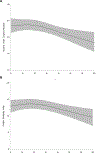Ambient traffic related air pollution in relation to ovarian reserve and oocyte quality in young, healthy oocyte donors
- PMID: 38103346
- PMCID: PMC10871039
- DOI: 10.1016/j.envint.2023.108382
Ambient traffic related air pollution in relation to ovarian reserve and oocyte quality in young, healthy oocyte donors
Abstract
Studies in mice and older, subfertile women have found that air pollution exposure may compromise female reproduction. Our objective was to evaluate the effects of air pollution on ovarian reserve and outcomes of ovarian stimulation among young, healthy females. We included 472 oocyte donors who underwent 781 ovarian stimulation cycles at a fertility clinic in Atlanta, Georgia, USA (2008-2019). Antral follicle count (AFC) was assessed with transvaginal ultrasonography and total and mature oocyte count was assessed following oocyte retrieval. Ovarian sensitivity index (OSI) was calculated as the total number of oocytes divided by total gonadotrophin dose × 1000. Daily ambient exposure to nitric oxide (NOx), carbon monoxide (CO), and particulate matter ≤ 2.5 (PM2.5) was estimated using a fused regional + line-source model for near-surface releases at a 250 m resolution based on residential address. Generalized estimating equations were used to evaluate the associations of an interquartile range (IQR) increase in pollutant exposure with outcomes adjusted for donor characteristics, census-level poverty, and meteorological factors. The median (IQR) age among oocyte donors was 25.0 (5.0) years, and 31% of the donors were racial/ethnic minorities. The median (IQR) exposure to NOx, CO, and PM2.5 in the 3 months prior to stimulation was 37.7 (32.0) ppb, 612 (317) ppb, and 9.8 (2.9) µg/m3, respectively. Ambient air pollution exposure in the 3 months before AFC was not associated with AFC. An IQR increase in PM2.5 in the 3 months before AFC and during stimulation was associated with -7.5% (95% CI -14.1, -0.4) and -6.4% (95% CI -11.0, -1.6) fewer mature oocytes, and a -1.9 (95% CI -3.2, -0.5) and -1.0 (95% CI -1.8, -0.2) lower OSI, respectively. Our results suggest that lowering the current 24-h PM2.5 standard in the US to 25 µg/m3 may still not adequately protect against the reprotoxic effects of short-term PM2.5 exposure.
Keywords: Air pollution; Fertility; Ovarian reserve; Particulate matter.
Copyright © 2023 The Author(s). Published by Elsevier Ltd.. All rights reserved.
Conflict of interest statement
Declaration of Competing Interest The authors declare the following financial interests/personal relationships which may be considered as potential competing interests: Zsolt P Nagy reports a relationship with CooperSurgical Inc that includes: board membership. Zsolt P Nagy reports a relationship with Prelude Fertility Inc that includes: equity or stocks. Daniel B Shapiro reports a relationship with Prelude Fertility Inc that includes: equity or stocks.
Figures

Similar articles
-
Association of exposure to ambient air pollution with ovarian reserve among women in Shanxi province of north China.Environ Pollut. 2021 Jun 1;278:116868. doi: 10.1016/j.envpol.2021.116868. Epub 2021 Mar 3. Environ Pollut. 2021. PMID: 33735795
-
Air pollution exposure in vitrified oocyte donors and male recipient partners in relation to fertilization and embryo quality.Environ Int. 2024 Nov;193:109147. doi: 10.1016/j.envint.2024.109147. Epub 2024 Nov 13. Environ Int. 2024. PMID: 39547088 Free PMC article.
-
The influence of fine particulate matter on the association between residential greenness and ovarian reserve.Environ Res. 2021 Jun;197:111162. doi: 10.1016/j.envres.2021.111162. Epub 2021 Apr 24. Environ Res. 2021. PMID: 33905704 Free PMC article.
-
Exposure to air pollution and ovarian reserve parameters.Sci Rep. 2024 Jan 3;14(1):461. doi: 10.1038/s41598-023-50753-6. Sci Rep. 2024. PMID: 38172170 Free PMC article.
-
Fine particulate matter and ovarian health: A review of emerging risks.Heliyon. 2024 Nov 19;10(22):e40503. doi: 10.1016/j.heliyon.2024.e40503. eCollection 2024 Nov 30. Heliyon. 2024. PMID: 39650185 Free PMC article. Review.
Cited by
-
Higher oxidative balance score is associated with lower female infertility: a cross-sectional study.Front Nutr. 2024 Dec 4;11:1484756. doi: 10.3389/fnut.2024.1484756. eCollection 2024. Front Nutr. 2024. PMID: 39703331 Free PMC article.
-
Ambient temperature in relation to ovarian reserve and early outcomes following ovarian stimulation and in vitro fertilization.Environ Res. 2025 Apr 15;271:121117. doi: 10.1016/j.envres.2025.121117. Epub 2025 Feb 13. Environ Res. 2025. PMID: 39952458
-
The role of epigenetics in women's reproductive health: the impact of environmental factors.Front Endocrinol (Lausanne). 2024 Sep 13;15:1399757. doi: 10.3389/fendo.2024.1399757. eCollection 2024. Front Endocrinol (Lausanne). 2024. PMID: 39345884 Free PMC article. Review.
-
A retrospective study on the association of ambient air pollutants and temperature co-exposure with female infertility risk in Chengdu, China.Sci Rep. 2025 May 28;15(1):18605. doi: 10.1038/s41598-025-03601-8. Sci Rep. 2025. PMID: 40437115 Free PMC article.
References
-
- Abareshi F, Sharifi Z, Hekmatshoar R, Fallahi M, Lari Najafi M, Ahmadi Asour A, Mortazavi F, Akrami R, Miri M, Dadvand P, 2020. Association of exposure to air pollution and green space with ovarian reserve hormones levels. Environ. Res. 184, 109342. - PubMed
-
- Alduchov OA, Eskridge RE, 1996. Improved magnus form approximation of saturation vapor pressure. J. Appl. Meteorol. Climatol. 35 (4), 601–609.
-
- Anderson RA, Nelson SM, Wallace WH, 2012. Measuring anti-Müllerian hormone for the assessment of ovarian reserve: when and for whom is it indicated? Maturitas 71 (1), 28–33. - PubMed
-
- Bates JT, Pennington AF, Zhai X, Friberg MD, Metcalf F, Darrow L, Strickland M, Mulholland J, Russell A, 2018. Application and evaluation of two model fusion approaches to obtain ambient air pollutant concentrations at a fine spatial resolution (250m) in Atlanta. Environ. Model. Softw. 109, 182–190.
-
- Broekmans FJ, de Ziegler D, Howles CM, Gougeon A, Trew G, Olivennes F, 2010. The antral follicle count: practical recommendations for better standardization. Fertil. Steril. 94 (3), 1044–1051. - PubMed
MeSH terms
Substances
Grants and funding
LinkOut - more resources
Full Text Sources
Medical

